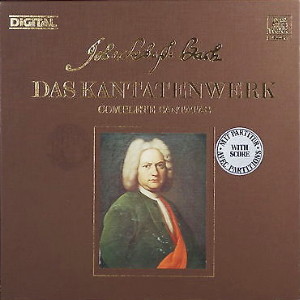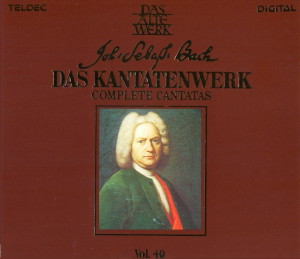 |
|
2 LPs
- 6.35659 EX - (p) 1987
|
 |
| 2 CDs -
8.35659 ZL - (p) 1987 |
|
| DAS KANTATENWERK - Volume 40 |
|
|
|
|
|
|
|
| Johann Sebastian
BACH (1685-1750) |
Kantate
"Vergnügte Ruh, beliebte Seelenlust",
BWV 170
|
|
22' 39" |
|
|
Am
6. Sonntag nach Trinitatis (Dominica 6
post Trinitatis)
|
|
|
|
|
Text:
Georg Christian Lehms, 1711 (1-5) |
|
|
|
|
Solo:Alt;
Oboe d'amore; Streicher; Basso continuo
(Violoncello, Violone, Organo); Organo
obligato a 2 Clav.
|
|
|
|
|
- 1.
[Aria] (Alto): "Vergnügte Ruh, beliebte
Seelenlust" |
6' 17" |
|
A1 |
|
- 2.
Recitativo (Alto): "Die Welt, das
Sündenhaus, bricht nur in Höllenlieder
aus" |
1' 17" |
|
A2 |
|
- 3.
[Aria] (Alto): "Wie jammern mich doch die
verkehrten Herzen" |
8' 09" |
|
A3 |
|
- 4.
Recitativo (Alto): "Wer sollte sich
demnach wohl hier zu leben wünschen" |
1' 15" |
|
A4 |
|
- 5.
Aria (Alto): "Mir ekelt mehr zu leben" |
5' 44" |
|
A5 |
|
|
|
|
|
|
Kantate
"Erschallet, ihr Lieder", BWV 172 |
|
16' 44" |
|
|
Am
1. Pfingsttag (Feria 1 Pentecostes)
|
|
|
|
|
Text:
Anon. (Salomo Franck?) (1, 2-5); Johannes
14,23 (2): Philipp Nicolai, 1599 (6) |
|
|
|
|
Solo:
Sopran, Alt, Tenor, Baß - Chor; Tromba I,
II, III (Naturtrompete in C), Pauken;
Fagotto; Streicher; Basso continuo
(Violoncello, Violone, Organo) |
|
|
|
|
- 1.
Coro: "Erschallet, ihr Lieder, erklinget,
ihr Seiten!" |
4' 04" |
|
C1 |
|
- 2.
Recitativo (Basso): "Wer mich liebet" |
0' 54" |
|
C2 |
|
- 3.
Aria (Basso): "Heiligste Dreieinigkeit" |
2' 08" |
|
C3 |
|
- 4.
Aria (Tenore): "O Seelenparadies" |
4' 38" |
|
C4 |
|
- 5.
Aria (Duetto) (Soprano, Alto): "Komm, laß
mich nicht länger warten" |
3' 48" |
|
C5 |
|
- 6.
Choral (Coro): "Von Gott kömmt mir ein
Freudenschein" |
1' 15" |
|
C6 |
|
|
|
|
|
Matthias
Echternach (Solist des Knabenchores
Hannover), Sopran (BWV 172)
Paul Esswood, Alt (BWV 170
& 172)
Marius van Altena, Tenor (BWV 172)
Max van Egmond, Baß (BWV 172)
Knabenchor Hannover
| Heinz Hennig, Leitung
Collegium Vocale Gent | Philippe
Herreweghe, Leitung
LEONHARDT-CONSORT mit
Originalinstrumenten
- Bob van Asperen, Organo obligato
- Friedemann Immer, Klaus Osterloh, Susan
Williems, Tromba (Naturtrompete in C)
- Maarten van der Valk, Pauken
- Ku Ebbinge, Oboe d'amore
- Frans Berkhout, Fagotto
- Marie Leonhardt, Alda Stuurop, Marc
Destrubé, Antoinette van den Hombergh,
Marinette Troost, Violinen
- Staas Swiestra, Ruth Hesseling, Viola
- Wouter Möller, Richte van der Meer, Violoncello
- Anthony Woodrow, Violone
- Gustav Leonhardt (BWV 170/2,3; 172/2,5),
Bob van Asperen (BWV 170/1,4; 172/1,3,4,6),
Organo
Gustav Leonhardt, Gesamtleitung
|
|
|
|
|
Luogo
e data di registrazione |
|
Doopsgezinde Kerk,
Haarlem (Holland) - Dicembre 1985
|
|
|
Registrazione: live
/ studio |
|
studio |
|
|
Producer |
|
Wolf Erichson
|
|
|
Prima Edizione LP |
|
Teldec "Das Alte
Werk" | 6.35659 EX | 2 LPs -
durata 38' 57" - 51' 41" | (p)
1987 | DIGITAL DMM
|
|
|
Edizione CD |
|
Teldec Classics |
LC 6706 | 8.35659 ZL | 2 CDs -
durata 38' 57" - 51' 41" | (p)
1987 | DDD |
|
|
Cover
|
|
Johann Sebastian
Nach, einige Jahre vor seiner
Ernennung zum Kantor in Leipzig.
Gemälde con JJ. Ihle (1720) Bach
Museum Eisenach.
|
|
|
Note |
|
In questo volume sono
presenti anche La Cantate BWV 171,
BWV 173 e BWV 174 a cura del
Concentus Musicus Wien diretto da
Nikolaus Harnoncourt.
|
|
|
|
|
INTRODUCTION
by Gerhard Schuhmacher
"Vergnügte Ruh, beliebte
Seelenlust" (BWV 170)
was written for the Sixth
Sunday after Trinity (July
28) 1726. We can assume that
Bach performed the brief
work together with a cantata
by his Meiningen cousin
Johann Ludwig Bach in the
same church service, instead
of a two-part cantata
(before and after the
sermon). Bach took the text
from Georg Christian Lehms’s
cantata yearbook for 1711:
the subject is Christian
righteousness and the
fulfilment of the Pharisee’s
laws. The pastoral title
aria begins without an
introductory movement: the
oboe d’amore plays in unison
with the first violin and
forms a bridge to the timbre
of the alto voice, radiating
an atmosphere of great calm.
In the fully composed da
capo, the epilogue
corresponds to the
introduction. The contrast
follows after the recitative
(No. 2) in the aria "Wie
jammern mich doch die
verkehrten Herzen” with
obbligato organ (two manuals
without bass) and unison
violins and viola with the
alto. The basso continuo as
the “end and origin of all
music" is absent: Bach
deliberately composed what
he referred to in a famous
comment as “an infernal
whining and drawling." The
figures at ”Rache"
(rengeance) ”erfreun”
(rejoice) and ”frech"
(frendish) that seem wrong
in combination and the trill
on ”verlacht” make it clear
that the attitude of the
Pharisees is exposed here.
The text turns to God in the
accompagnato, then follows
the triumphant aria of the
soul turning away from the
world. The rapid organ
figures emphasize how
distasteful the world has
become ("mir ekelt...").
"Erschallet, ihr Lieder"
(BWV 172) was probably
composed rn Weimar for
Whitsunday of 1714 (May 20).
Bach performed the work at
least three more times,
making alterations on each
occasion. A D major version
of this cantata from the
Leipzig period corresponds
approximately to the pitch
of the Weimar Chorton (C
major). In this recording
the work is heard in C
major. The author of the
text rs not named, nor is he
known from the printed text:
however, Bach researchers
generally accept the
authorship of Salomo Franck,
since there are no freely
written recitatives (the
only recitative has a
Biblical text). Timpani and
trumpets symbolize God's
kingship as the musical
theme of the resplendent
opening movement in da capo
form. The bass recitative
(Christ’s words) is followed
by the aria ”Heiligste
Dreieinigkeit" with the
symbolic instrumentation
(rare for Bach) of three
trumpets, timpani and basso
continuo accompanying the
solo bass voice. The vocal
figures are derived entirely
from those of the heraldic
trumpet part. After the
weight of this aria, the
tenor' aria "O
Seelenparadies, das Gottes
Geist durchwehet” with the
calm flow of the unison
strings seems to be unbound
by the force of gravity. The
pietistic itlea of the
personification of the soul
is hinted at, and becomes
concr'ete in the duet (No.
5) with the ”Hirnmelswind”
(Heaven mild; alto), which
is obviously the poet’s
attempt to get out of a
predicament: the idea of
bridal mysticism (the
comforter as briedegroom of
the soul) did not seem
appropriate in connection
with Whitsun and the
Trinity, The chorale ”Von
Gott kömmt mir einen
Freudenschein” likewise
suggests the symbolism,
though. The duet is made
especially elaborate by the
figured chorale ”Kornrn,
heiliger Geist” in the
continuo.
|
  |
|
|